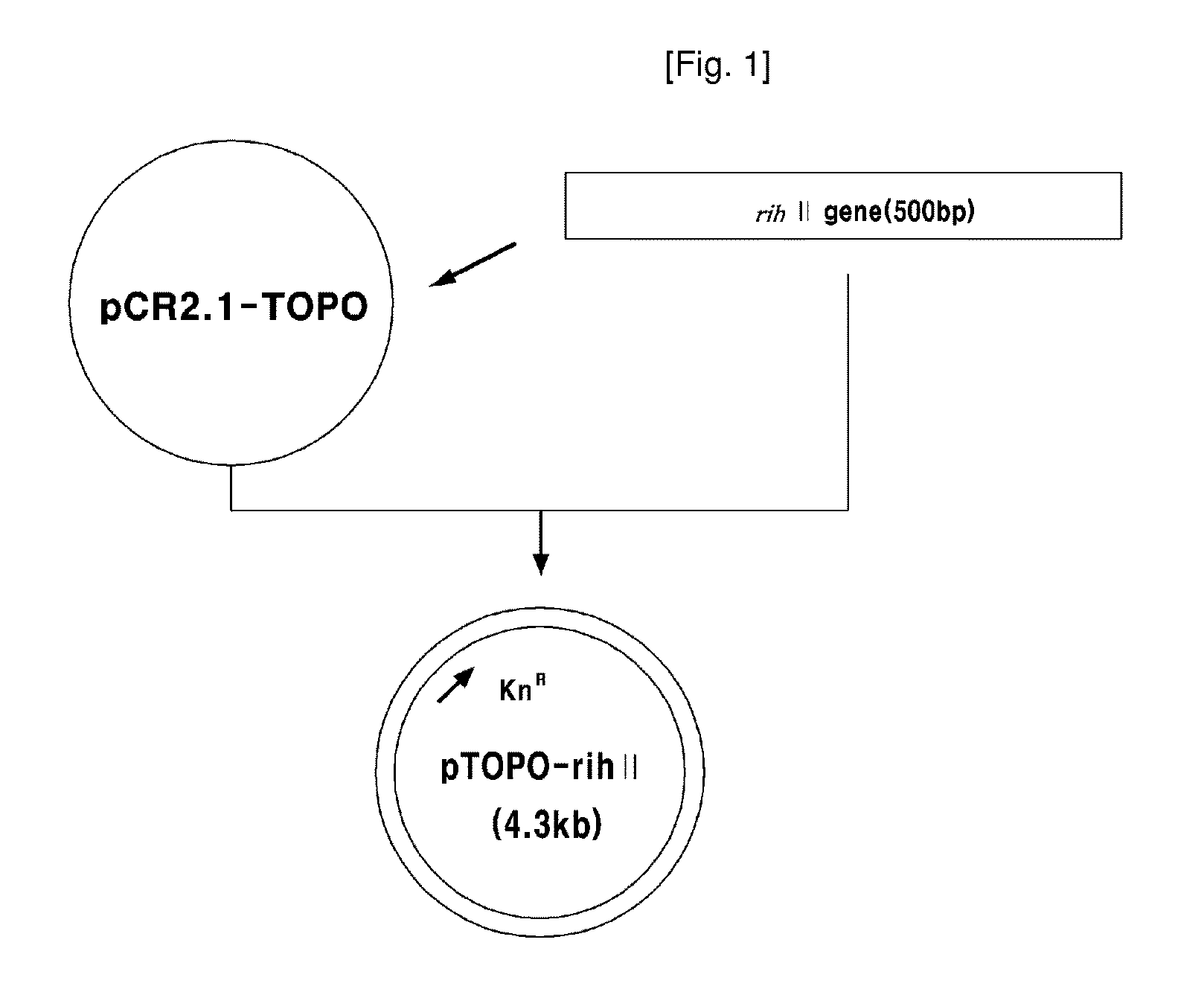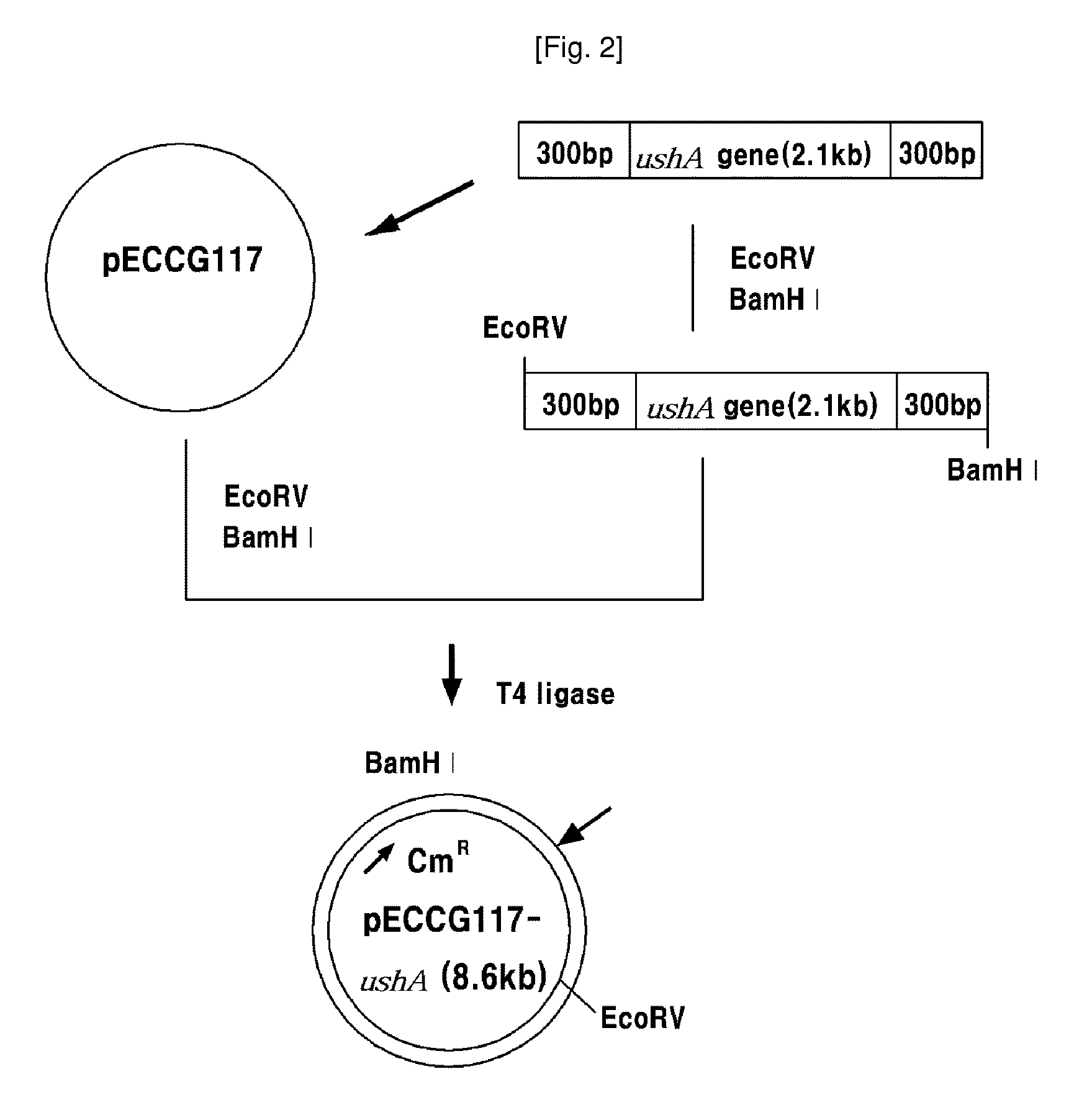Microorganism Producing Inosine and Method of Producing Inosine Using the Same
a technology of inosine and microorganisms, applied in the field of microorganism producing inosine, can solve the problems of low productivity, increase in production cost, and inapplicability, and achieve the effect of high yield
- Summary
- Abstract
- Description
- Claims
- Application Information
AI Technical Summary
Benefits of technology
Problems solved by technology
Method used
Image
Examples
example 1
[0051]In this example, 1326 by rih II gene fragment (SEQ. ID. NO: 1) was amplified by PCR using chromosomal DNA of the wild type Corynebacterium ammoniagenes ATCC 6872 as a template with primers of oligonucleosides represented by SEQ. ID. NO: 3 and NO: 4 to construct the vector (rih II gene disruption vector) containing a part of rih II gene encoding nucleoside hydrolase II and an antibiotic marker. PCR was performed as follows; denaturation at 96° C. for 30 seconds, annealing at 52° C. for 30 seconds, and polymerization at 72° C. for 30 seconds (30 cycles). The amplified rih II gene fragment was cloned into the plasmid pCR2.1-TOPO (Invitrogen Co., USA). As a result, pTOPO-rih II vector was obtained. The cloning process of rih II gene fragment and the cloned vector pTOPO-rih II are illustrated in FIG. 1.
[0052]Corynebacterium ammoniagenes CJIP2401 (KCCM-10610) was transformed with the constructed pTOPO-rih II vector by electroporation. Then, single colonies grow...
example 2
[0056]In this example, 2115 by ushA gene fragment (SEQ. ID. NO: 2) was amplified by PCR using chromosomal DNA of the wild type Corynebacterium ammoniagenes ATCC 6872 as a template with primers of oligonucleosides represented by SEQ. ID. NO: 5 and NO: 6. PCR was performed as follows; denaturation at 96° C. for 30 seconds, annealing at 52° C. for 30 seconds, and polymerization at 72° C. for 30 seconds (30 cycles). The obtained gene fragment was digested with EcoRV and BamHI. The gene fragment was ligated to linear pECCG117 vector digested with the same DNA restriction enzymes by using DNA T4 ligase. As a result, pECCG117-ushA vector was obtained. The cloning process of ushA gene fragment and the cloned vector pECCG117-ushA are illustrated in FIG. 2.
[0057]The mutant strain prepared in Example 1 was transformed with the constructed pECCG117-ushA vector by electroporation. Then, single colonies growing on CM solid medium (gravy 10 g / L, yeast extract 10 g / L, bactopepto...
example 3
Fermentation Test in Erlenmeyer Flask
[0060]3 ml of seed medium was distributed in test tubes of 18 mm in diameter, which were sterilized by autoclave. Corynebacterium ammoniagenes CJIG650 (KCCM-10828P), CJIG651 (KCCM-10829P) and the parent strain (KCCM-10610) were inoculated in the test tubes respectively, followed by shaking culture at 30° C. for 24 hours to prepare seed culture solution. 27 ml of fermentation medium was distributed in 500 ml Erlenmeyer flask for shaking, which was sterilized by autoclave at 120° C. for 10 minutes. After inoculation of 3 ml of the seed culture solution, culture was performed for 4˜5 days. RPM was regulated as 200 and temperature was set at 32° C. and pH was regulated as 7.2.
[0061]The compositions of the seed medium and the fermentation medium are as follows.
[0062]Seed medium Glucose 5%, Peptone 0.5%, Gravy 0.5%, Yeast extract 1%, Sodium chloride 0.25%, Adenine 100 mg / l, Guanine 100 mg / l, pH7.2
[0063]Flask fermentation medium: Sodium glutamate 0.1%, ...
PUM
| Property | Measurement | Unit |
|---|---|---|
| diameter | aaaaa | aaaaa |
| temperature | aaaaa | aaaaa |
| concentration | aaaaa | aaaaa |
Abstract
Description
Claims
Application Information
 Login to View More
Login to View More - R&D
- Intellectual Property
- Life Sciences
- Materials
- Tech Scout
- Unparalleled Data Quality
- Higher Quality Content
- 60% Fewer Hallucinations
Browse by: Latest US Patents, China's latest patents, Technical Efficacy Thesaurus, Application Domain, Technology Topic, Popular Technical Reports.
© 2025 PatSnap. All rights reserved.Legal|Privacy policy|Modern Slavery Act Transparency Statement|Sitemap|About US| Contact US: help@patsnap.com



